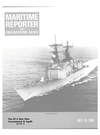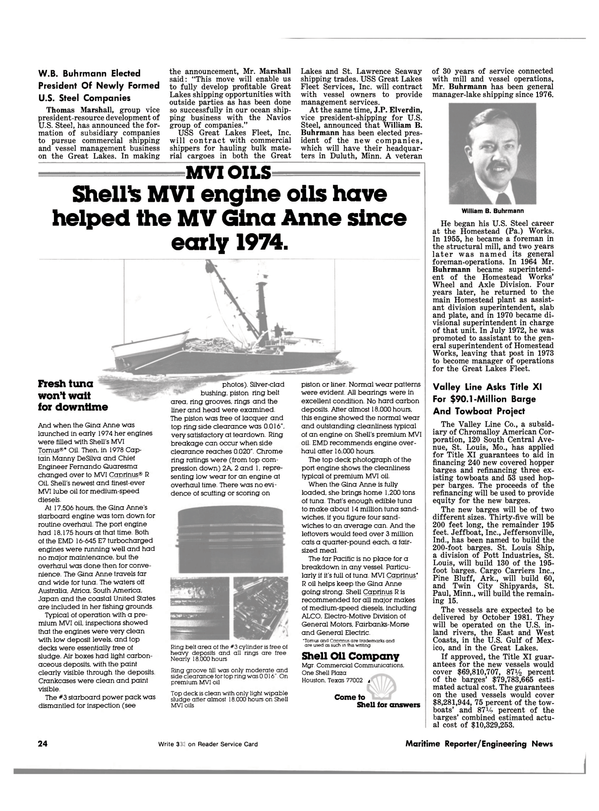
David Taylor Naval R&D Center Hosts Hydromechanics Meeting
The David Taylor Naval Ship R&D Center (DTNSRDC), Carderock, Md„ hosted the 1981 Naval Sea Systems Command Hydromechanics Committee (SEAHAC) recently. The two-day meeting was attended by nearly 200 persons representing the private sector, academic institutions, and Navy activities. The meeting is held annually and provides a forum for the transfer of technology.
SEAHAC, established in 1950, acts as an advisory body for research and development in the field of naval hydromechanics.
This committee is comprised of representatives from the Naval Sea Systems Command together with representatives from Navy laboratories, National Bureau of Standards, the Office of Naval Research, and the Naval Academy.
SEAHAC is responsible for making specific recommendations regarding the technical objectives, forecast of research needs, development of priorities, order of procedures, methods and means of investigations, and related items of importance.
Technical subcommittees of SEAHAC are organized to represent the following principal technology areas in the field of naval hydromechanics: resistance and propulsion, seakeeping, maneuvering and control, propulsors, hydro-acoustics, fluid /structure interaction, and weapon launch.
In addition to these areas, topics of the meeting included overviews of current Navy research programs and current exploratory development programs.
Rear Adm. James W. Lisanby, USN, Deputy Commander for Ship Design and Integration, Naval Sea Systems Command, was guest speaker at the luncheon held on May 19. He reviewed briefly recent progress on ship R&D by reflecting on remarks he had made at the 18th Towing Tank Conference in August 1977.
To this end he recalled the following suggestions he had made then and identified recent accomplishments for each: (1) "Better c o o r d i n a t i o n , cooperation, and communication among Navy policymakers, researchers, designers, and ship forces in establishing R&D priorities.
(2) "More pooling of resources within the engineering community.
(3) "A closer working relationship among the ship acquisition and R&D managers, and especially, ship designers and researchers.
(4) "Sharpen the long-range vision of the ship designer so that he or she could look ahead and predict 15 years hence what our ships will require.
(5) "We need a continuing educational program available to ensure that our engineers have a sharper ship design vision by maintaining s t a t e - o f - t h e - a rt knowledge and skills, both theoretical and experimental." He said further: "The importance of timely technology transfer is evident by the many advances in our Navy's Fleet which have evolved over the years from NAVSEA's hydrodynamics R&D programs. Many of you here today personally contributed to these advances. We are all aware of the high-speed submarine hull forms, higher speed torpedoes and improved underwater launch systems. To this we could add skewed propellers f o r reduced ship vibrations, improved submarine maneuvering and control, reliable submarine emergency recovery procedures, and many others. More recently, the application of seakeeping technology to surface ship designs has significantly contributed to improving the performance of future naval ships as well as those in the Fleet today." In summary, Admiral Lisanby said: "SEAHAC plays a most valuable role in the acquisition of technically innovative ships and weapons by pointing the way in the hydromechanics research.
A concerted effort by SEAHAC is essential to predicting the future Fleet requirements, identifying the present technical obstacles, and developing the research programs to overcome them."
Read David Taylor Naval R&D Center Hosts Hydromechanics Meeting in Pdf, Flash or Html5 edition of July 15, 1981 Maritime Reporter
Other stories from July 15, 1981 issue
Content
- Bay Building Barge With First Conveyor To Handle Wet Phosphate Rock page: 6
- Robert Ware Establishes His Own Maritime Public Relations Service page: 7
- Circular Detailing New Suez Canal Regulations Available From Candia page: 7
- IMODCO Receives Order From Petrobras For $5-Million SPM Terminal page: 7
- Wartsila Turku Shipyards Delivers Superferry 'Silvia Regina' page: 8
- U.S. Combat Systems In Foreign Built Ships Topic At ASNE Meeting page: 8
- Puget Sound Tug & Barge Will Build 12 Barges Costing $39.5 Million page: 9
- Seaco Energy/Coastal Carriers Joint Venture Plans Floating Terminals page: 9
- First Of New Destroyer Class Commissioned At Ingalls Yard page: 10
- Santa Fe Diving Services Awarded Contract To Provide RCV And Crew page: 10
- National Steel Lays Keel For U.S. Navy Cable Repair Vessel page: 10
- Second Crandali Dock At National Sea Products Yard Rebuilt And Enlarged page: 12
- Anthony McAllister Jr. Elected Chairman Of New York Towboat Association page: 14
- $172-Million Navy Order To Bell For New Type Landing Craft page: 14
- Theriot-Modec To Build Ammonia Barge For Energy Transportation Subsidiary page: 15
- Edward Campbell Named To Board Of Trustees At Webb Institute page: 15
- $140-Million Contract For Two Offshore Rigs Awarded To Gotaverken Arendal Shipyard page: 16
- Benson, Basse And David Join Tampa Barge In Management & Production page: 16
- Delaware Valley ASNE Chapter Discusses Government Contracting page: 16
- Hudson Delivers The 'Gulf Dolphin7 To Gulf Fleet Marine page: 18
- Third Seaboard RO/RO Ordered At Fredriksstad Yard Will Have MacGregor Hoistable Decks page: 18
- Grumman Hydrofoil For Israel Launched At Lantana Boatyard page: 20
- Dravo-Built Towboats For China Get A Lift From Dock Express page: 20
- Petronio Elected VP-Engineering At Pool Company Of Houston page: 21
- Two MARCO Oil Skimmers Delivered To Mexican Navy page: 21
- David Taylor Naval R&D Center Hosts Hydromechanics Meeting page: 22
- W.B. Buhrmann Elected President Of Newly Formed U.S. Steel Companies page: 24
- Valley Line Asks Title XI For $90.1-Million Barge And Towboat Project page: 24
- Petro Marine Services To Build $25-Million Shipyard In Alaska page: 26
- Riverway Completes Second Drydock For Its Own Repair Division page: 27
- New Brochure Describes National Crane's Line Of Marine Lifting Systems page: 27
- Shipyard Conference Honors Past Chairmen McKay And Pirozzolo page: 28
- HUDSHIP To Build Four Big Towing/Supply Vessels For Zapata page: 29
- U.S. And Canada Agree To Cooperate In Marine Transportation R &D page: 34
- Philadelphia Resins' New Brochure Describes The Company And Its Products page: 34
- Griffin & Alexander Jackup Rig Commissioned At Bethlehem-Beaumont page: 35
- Lima Electric Announces New Model Alternator- Literature Available page: 35
- Raytheon Opens New Marine Sales And Service Facility In Mississippi page: 36
- Partnership Between AMCA International & McDermott Formally In Business page: 36
- Seminars On Rig Moves Organized By Marine Design International page: 37
- Dome Acquires Davie Shipbuilding At Total Cost Of $38.6 Million page: 38
- Riverway Shipyard Delivers GM-Powered Towboat 'Waterways Explorer7 page: 38
- Largest DMI Dredge Delivered To Mexican Owner page: 39
- Rubber Fendering Reduces Damage To Vessels And Piers page: 40
- Sembawang Yard Completes Multimillion-Dollar Overhaul Job On McDermott Barge page: 40
- APL Ready To Build 45-Foot Production Unit Containers page: 41
- Tracor Marine Awarded $2.5-Million Navy Contract To Manage OCEI Facilities page: 42
- Ned Smith Named Vice President-Finance For American Steamship page: 42
- Dravo To Provide People's Republic With Technical Assistance And Equipment page: 42
- McDermott Incorporated Promotes Four To « Vice President Posts page: 43
- Multipurpose Cargo Vessel Launched At GHH Sterkrade Yard page: 44
- New York Maritime Day Ceremonies Featured Presentation Of Two Awards page: 58
- Todd Shipyards Awarded Navy Study Contract On DDGX Producibility page: 58
- Butterworth Tank Washing Machines Ordered For Eight New Product Carriers page: 59
- Bulk Carrier 'Star Of Texas7 Launched At Levingston Yard page: 59


